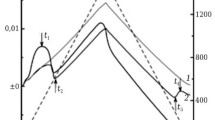Abstract
A correlation analysis of the thermal stability of oxide-based ceramic materials (including partially yttria-stabilized zirconia (PYSZ), beta-alumina, and titanium dioxide) produced in batches by different technologies is carried out. A generalized criterion for thermal stability is proposed that takes into account partial compensation of the thermally generated elastic strain owing to compliant behavior of the network of surface cracks. The criterion provides a satisfactory description of experimental data, allows prediction of the behavior of materials under severe thermomechanical conditions, and suggests ways toward further improvement of material properties.
Similar content being viewed by others
REFERENCES
K. K. Strelov, Structure and Properties of Refractory Materials [in Russian], Metallurgiya, Moscow (1982).
R. A. Andrievskii and I. I. Spivak, The Strength of High-Melting Compounds and Materials [in Russian], Metallurgiya, Chelyabinsk (1989).
G. A. Gogotsi, “An analysis of thermal stability criteria in deformable refractories, ” Ogneupory, No. 5, 45-50 (1977).
I. Yu. Prokhorov, G. Ya. Akimov, A. A. Dabizha, and V. V. Storozh, The Weibull Modulus and Hydrostatic Processing of Ceramics [in Russian], Preprint DonFTI-91-5, Donetsk (1991).
G. Ya. Akimov, I. Yu. Prokhorov, I. V. Gorelik, et al., “Cold isostatic pressing and properties of a ZrO2-based ceramic prepared from ultradisperse powders, ” Ogneupory, No. 2, 12-19 (1995).
I. Yu. Prokhorov, G. Ya. Akimov, V. M. Timchenko, and A. D. Vasil'ev, “Cold isostatic pressing as a technique for ZrO2-based high-strength ceramic materials, ” Ogneup. Tekh. Keram., No. 8, 12-17 (1997).
I. Yu. Prokhorov, “Zirconia materials from coprecipitated powders, ” Ogneup. Tekh. Keram., No. 12, 6-13 (1997).
Y. Masahiro and S. Somiya, Seramikkusu, 21(2), 126-134 (1986).
A. G. Gashchenko, G. A. Gogotsi, A. G. Karaulov, et al., “Thermal stability and mechanical properties of zirconia-based materials, ” Probl. Prochn., No. 6, 76-80 (1974).
D. F. Kalinovich, L. I. Kuznetsova, and É. T. Denisenko, “Zirconium dioxide: properties and application (review), ” Poroshk. Metall., No. 11, 98-103 (1987).
A. G. Évans and T. G. Langdon, Structural Ceramics [Russian translation], Metallurgiya, Moscow (1980).
V. L. Balkevich, Engineering Ceramics [in Russian], Stroiizdat, Moscow (1984).
N. M. Bobkova and L. M. Silich, “Heat-resistant ceramics and glass ceramics based on aluminum titanate, ” Zh. Vses. Khim. Ob-va, 36(5), 564-569 (1991).
K. Hamano, “Microstructure and mechanical strength of an aluminum titanate-based ceramic prepared from a mixture alumina and titania, ” Yogyo Kyokai Shi, 91(2), 94-101 (1983).
N. L. Carter and H. C. Heard, “Temperature and rate dependent deformation of halite, ” Am. J. Sci., 269(10), 193-249 (1970)
D. I. Sedov, Mechanics of Continua [in Russian].
J. M. Krafft and J. R. Irvin, “Concerning the crack propagation velocity, ” in: Applied Problems in Fracture Toughness. Collection of Research Papers [Russian translation], Mir, Moscow (1968), pp. 187-212.
J. Congleton, N. J. Petch, and S. A. Shiels, “The brittle fracture of alumina below 1000°C, ” Phil. Mag., 19(160), 795-807 (1969).
A. I. Kozachuk, I. Yu. Solntseva, V. A. Stepanov, and V. V. Shpeizman, “The loading rate and its role in the fracture of brittle bodies, ” Fiz. Tverd. Tela, 25, Issue 7, 1945-1952 (1983).
P. W. Tasker, “The surface energies, surface tensions and surface structure of the alkali-halides crystals, ” Phil. Mag., 39(2), Part 1, 119-136 (1979).
J. J. Gilman, “Direct measurements of the surface energies of crystals, ” J. Appl. Phys., 31(12), 2208-2218 (1960).
E. Siegel, “Application of phonon theory of brittle fracture to shock spallation, ” Scr. Met., 6(9), 785-787 (1972).
I. Yu. Prokhorov and G. Ya. Akimov, “The crack resistance of hydrostatically compressed alkali-halide single crystals, ” Probl. Prochn., No. 7, 23-28 (1987).
I. Yu. Prokhorov, The Effect of Hydrostatic Pressure on the Fracture of Crystalline Materials, Author's Abstract of Candidate's Thesis [in Russian], Donetsk (1991).
I. P. Frantsevich, F. F. Voronov, and S. A. Bakuta, Elastic Constants and Moduli of Elasticity of Metals and Nonmetals. Handbook [in Russian], Naukova Dumka, Kiev (1982).
J.-L. Shi, J. H. Gao, Z.-X. Lin, and T.-S. Yen, “Sintering behavior of fully agglomerated zirconia compacts, ” J. Am. Chem. Soc., 74(5), 994-997 (1991).
I. Yu. Prokhorov, G. Ya. Akimov, and V. M. Timchenko, “Stability of ZrO2-based structural materials, ” Ogneup. Tekh. Keram., No. 6, 2-11 (1998).
Author information
Authors and Affiliations
Rights and permissions
About this article
Cite this article
Prokhorov, I.Y. Thermal Stability of Oxide-Based Ceramic Materials. Refractories and Industrial Ceramics 43, 195–205 (2002). https://doi.org/10.1023/A:1020579419633
Issue Date:
DOI: https://doi.org/10.1023/A:1020579419633




